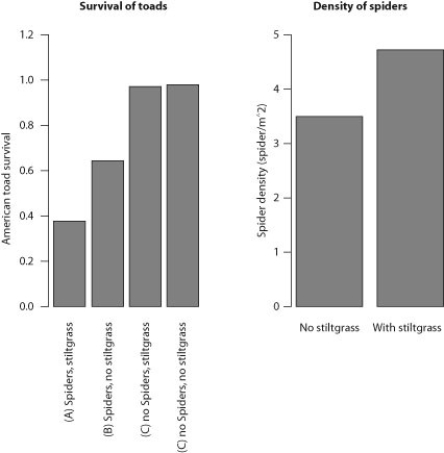Japanese stiltgrass is an invasive plant that was accidentally introduced to the United States in the early 1900s. It can be found on roadsides and in forests, and it has many impacts on native plants and animals. Biologists Jayna DeVore and John Maerz studied the effect of Japanese stiltgrass on American toads in their natural habitat. They enclosed American toads in cages with lycosid spiders and/or Japanese stiltgrass. The four treatments were (A) lycosid spiders and Japanese stiltgrass, (B) lycosid spiders without Japanese stiltgrass, (C) lycosid spiders and Japanese stiltgrass, and (D) no lycosid spiders and no Japanese stiltgrass. They compared the survival of American toads across the treatments (left graph) . They also measured the density of lycosid spiders in different areas where Japanese stiltgrass was absent vs. present (right graph) .
 Source: DeVore, J. L., & Maerz, J. C. (2014) . Grass invasion increases top‐down pressure on an amphibian via structurally mediated effects on an intraguild predator. Ecology, 95(7) , 1724-1730.
Source: DeVore, J. L., & Maerz, J. C. (2014) . Grass invasion increases top‐down pressure on an amphibian via structurally mediated effects on an intraguild predator. Ecology, 95(7) , 1724-1730.
-What hypothesis is best supported by these results?
Definitions:
Critical Response
The evaluation or analysis of a work of art, literature, or performance, often involving both positive and negative feedback from critics or the general public.
Contemporary Work
Refers to art, literature, music, or any creative endeavor produced in the current period or very recently.
Remaking Impressionism
The process or trend of revisiting and reinterpretation of the Impressionist movement in art, which originally emerged in the late 19th century focusing on capturing light and natural forms.
Permanent
Lasting or intended to last or remain unchanged indefinitely.
Q1: A regional assemblage of interacting ecosystems is
Q13: Global warming due to the greenhouse effect
Q16: The process of a white blood cell
Q20: _ cells lack a membrane-enclosed nucleus.<br>A) Plant<br>B)
Q34: An important function of the bones in
Q52: Secretory proteins are<br>A) produced by ribosomes on
Q54: Which example is most clearly a case
Q65: According to the data, this remediation plan
Q65: In the reaction A → B +
Q73: Photosynthesis occurs in which type of plant